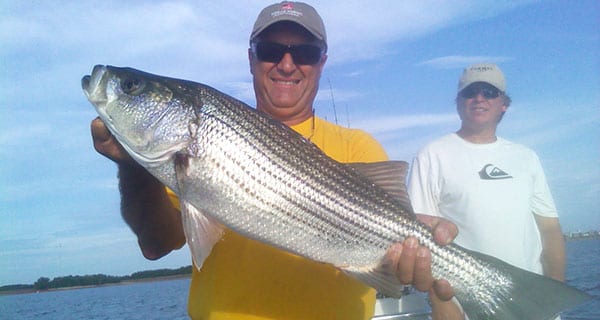I was at the courthouse the other day in my capacity as a contractor when a fellow passed by and said, “You must be a guide”. I was a little surprised and said yes I was and he went on his way. Afterwards I thought (as is usual) a great line of return would have been “What gave me away the sight or the smell?” That encounter made me think about the little things, things that give away all the little secrets, that if observed properly and recognized, can lead you to some outstanding truths and subsequent outstanding catches. I remember reading years ago about Bill Dance picking up rocks at a new lake looking for crawdads so he could match the color of his baits to the color of the local bugs. Just the other day on Hartwell, after running through several coves looking for stripers, my son and I came to one with two ospreys circling and I said, “Now that’s a good sign” and sure enough, the cove was full of bait and fish. Fontana has several aviary friends that can point you to fish, Old Mr. Bald eagle is the most majestic sign of life while the kingfisher is almost always pointing out bait, flitting from bank to bank, even if you don’t see them dive, means there is food for them near. Not during this time of year, but wintertime brings a few seagulls and an occasional tern that is a surefire guide.
The best indicators of feeding fish are splashes as they break at the surface chasing threadfins or bluebacks. It amazes me that, as a guide, you assume folks know to throw to splashing fish, but many times I have pointed out breaks and had clients throw in the opposite direction. Summertime is an excellent time to chase breaking fish, and while you may troll through or towards topwater fish, breaks are an indication of feeding below the surface as well. Other indicators on Fontana are sometimes weather related. Wind that blows across a point will stack up bait and fish, look for current pushing by a point and the fish can be upstream, down stream or even way back and deep, I have seen schools stacked up downstream from a wind blown point as deep as 100 feet and a hundred yards away from the point itself. Add a little mud to the point and that can be a super spot at times. My buddy Frank once found a school of fish on a bank with really high wind blowing trees violently at the waterline. They were concentrating on the little inchworms and caterpillars being blown out of the trees into the water.
If you have a scenario where there are breaking fish and you can’t get them to bite there are a couple of things to stimulate them. My first go-to, especially in the summer, is to try and match the hatch. Lots of bait this time of year is really small, as small as 3/4 of an inch so a big crankbait ain’t gonna get bit. One trick is to tie a couple of small crappie jigs together so you have the right size and a little extra weight to throw. Trolling really small crappie plugs or XTS inch long minnow baits will get strikes especially when fish are scattered and moving around randomly chasing little groups of bait. One of my favorite baits and one I use year around is the Kitech swimbait. You would be surprised that some days they will hit only on the fall, other days they want them ripped back with big jerks and pauses, so try and vary your retrieve until you find out what they want. So, the point of this article is “be observant, you never know what is going to be the key that particular day.” I remember in my youth, during summer, we would fish farm ponds and you could smell the bream beds…that was as good an indicator as there was. I wonder what that fellow at the courthouse was going by, hope it wasn’t that. Give me a call and we will try and find a few. Later, Capt. James
Capt. James McManus is the Owner of 153 Charters. Give him a call for a great day of boat fishing!
